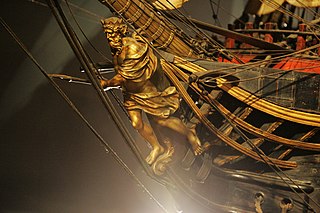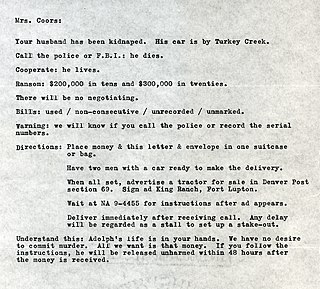
A clipper was a type of mid-19th-century merchant sailing vessel, designed for speed. Clippers were generally narrow for their length, small by later 19th century standards, could carry limited bulk freight, and had a large total sail area. "Clipper" does not refer to a specific sailplan; clippers may be schooners, brigs, brigantines, etc., as well as full-rigged ships. Clippers were mostly constructed in British and American shipyards, although France, Brazil, the Netherlands and other nations also produced some. Clippers sailed all over the world, primarily on the trade routes between the United Kingdom and China, in transatlantic trade, and on the New York-to-San Francisco route around Cape Horn during the California Gold Rush. Dutch clippers were built beginning in the 1850s for the tea trade and passenger service to Java.

Mystic is a village and census-designated place (CDP) in Groton and Stonington, Connecticut.

A barque, barc, or bark is a type of sailing vessel with three or more masts having the fore- and mainmasts rigged square and only the mizzen rigged fore and aft. Sometimes, the mizzen is only partly fore-and-aft rigged, bearing a square-rigged sail above.

A figurehead is a carved wooden decoration found at the bow of ships, generally of a design related to the name or role of a ship. They were predominant between the 16th and 20th centuries, and modern ships' badges fulfil a similar role.

Mystic Seaport Museum or Mystic Seaport: The Museum of America and the Sea in Mystic, Connecticut is the largest maritime museum in the United States. It is notable for its collection of sailing ships and boats and for the re-creation of the crafts and fabric of an entire 19th-century seafaring village. It consists of more than 60 historic buildings, most of them rare commercial structures moved to the 19-acre (0.077 km2) site and meticulously restored.

Shanghaiing or crimping is the practice of kidnapping people to serve as sailors by coercive techniques such as trickery, intimidation, or violence. Those engaged in this form of kidnapping were known as crimps. The related term press gang refers specifically to impressment practices in Great Britain's Royal Navy.

Joseph Conrad is an iron-hulled sailing ship, originally launched as Georg Stage in 1882 and used to train sailors in Denmark. After sailing around the world as a private yacht in 1934 she served as a training ship in the United States, and is now a museum ship at Mystic Seaport in Connecticut.

Lloyd's Register Group Limited (LR) is a technical and professional services organisation and a maritime classification society, wholly owned by the Lloyd’s Register Foundation, a UK charity dedicated to research and education in science and engineering. The organisation dates to 1760. Its stated aims are to enhance the safety of life, property, and the environment, by helping its clients to improve the safety and performance of complex projects, supply chains and critical infrastructure.

Charles W. Morgan is an American whaling ship built in 1841 that was active during the 19th and early 20th centuries. Ships of this type were used to harvest the blubber of whales for whale oil which was commonly used in lamps. Charles W. Morgan has served as a museum ship since the 1940s and is now an exhibit at the Mystic Seaport museum in Mystic, Connecticut. She is the world's oldest surviving (non-wrecked) merchant vessel, the only surviving wooden whaling ship from the 19th century American merchant fleet, and second to the USS Constitution, the oldest seaworthy vessel in the world. The Morgan was designated a National Historic Landmark in 1966.
Williams–Mystic, the Ocean and Coastal Studies Semester of Williams College and Mystic Seaport Museum, is an interdisciplinary semester program based at the Mystic Seaport Museum in Mystic, Connecticut.

The cabinet card was a style of photograph which was widely used for photographic portraiture after 1870. It consisted of a thin photograph mounted on a card typically measuring 108 by 165 mm.

Lettie G. Howard, formerly Mystic C and Caviare, is a wooden Fredonia schooner built in 1893 in Essex, Massachusetts, USA. This type of craft was commonly used by American offshore fishermen, and is believed to be the last surviving example of its type. She was declared a National Historic Landmark in 1989. She is now based at the South Street Seaport Museum in New York City.

L. A. Dunton is a National Historic Landmark fishing schooner and museum exhibit located at the Mystic Seaport Museum in Mystic, Connecticut. Built in 1921, she is one of three remaining vessels afloat of this type, which was once the most common sail-powered fishing vessel sailing from New England ports. In service in New England waters until the 1930s and Newfoundland into the 1950s. After a brief period as a cargo ship, she was acquired by the museum and restored to her original condition.

Emma C. Berry is a fishing sloop located at the Mystic Seaport Museum in Mystic, Connecticut, United States, and one of the oldest surviving commercial vessels in America. She is the last known surviving American well smack. This type of boat is also termed a sloop smack or Noank smack. The Noank design was imitated in other regions of the United States.

Brilliant is a schooner located at Mystic Seaport in Mystic, Connecticut, United States. Brilliant was built in 1932 on City Island, Bronx, by Henry B. Nevins Yard to a design by Olin Stephens of Sparkman & Stephens for Walter Barnum. Brilliant was built as an ocean racing yacht, and on her maiden voyage crossed the Atlantic Ocean in just over 15 days, 1 hour and 23 minutes, a record for a sailing yacht of her size. Brilliant ran from Nantucket Lightship to Bishop Rock Light, England.

Cremorne was a clipper ship of Sutton and Co.'s Dispatch Line and Coleman's California Line. She sailed between New York and San Francisco. Her services were advertised in sailing cards.

Manchester was a four-masted, steel-hulled British barque which was wrecked in late 1900 on the reefs of Bikar Atoll, Marshall Islands.
Clement Drew (1806–1889) was an artist and "dealer in picture-frames" in Boston, Massachusetts, in the 19th century. He specialized in marine paintings. He kept a studio on Court Street (ca.1840s-1860s), Tremont Street, Copeland Street (ca.1888), and Tremont Temple (1889). He married Elizabeth Teal in 1829; they had two children.

The sailing ship Andrew Jackson, a 1,679-registered-ton medium clipper, was built by the firm of Irons & Grinnell in Mystic, Connecticut in 1855. The vessel was designed for the shipping firm of J.H. Brower & Co. to carry cargo intended for sale to participants in the California Gold Rush.

Amazon is a 102-foot (31 m) long screw schooner and former steam yacht built in 1885 at the private Arrow Yard of Tankerville Chamberlayne in Southampton.




















